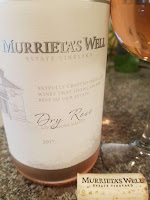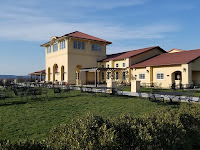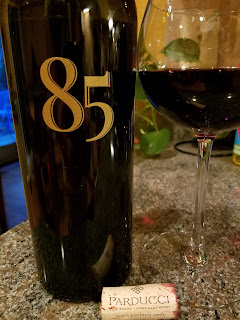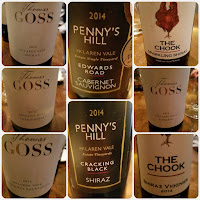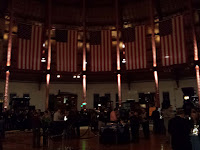I've driven through the intersection of Route 29 and Route 17 probably a hundred times on trips to Charlottesville and elsewhere but have never stopped at any of the wineries just south of Warrenton. That changed this past weekend as I traveled directly to the middle of Virginia's Piedmont in order to visit three area wineries.
Granite Heights is also located in the area but closes for the winter. And as always,
theCompass Winery, Brewery, Distillery Locator Mobile App will guide you to these wineries.
Molon Lave Vineyards

This winery is owned by the Papadopoulos family, the same Greek family who started
Mediterranean Cellars. The vines for Molon Lave were planted in 2003 with the winery and Tasting Room opening in late 2009. The utilize primarily estate fruit and are the first winery in Virginia to produce Kosher wines. A rabbi travels down from New York to supervise all phases from harvest to pressing and fermenting to ensure the designation. And like Mediterranean Cellars they produce a a traditional Greek Retsina styled wine, the
Kokineli ($28) rosé that has less of a resin profile than Mediterranean's version.
A tasting during this visit consisted of eight wines for $8 with a very traditional wine list (outside of the Kokinelli. The
2012 Chardonnay ($24) is one of their Kosher offerings and is showing nicely with lively acids and just a tad of butter from the oak treatment. The
2013 Viognier ($26) also sees some oak and is made off dry at 1.5% R.S. The acids penetrate any sweetness thus this wines tastes like dry honeysuckles. Their
2013 Pinot Grigio ($32) is also produced off dry at 2% R.S. and is a tasty wine, but $32 - for Pinot Grigio - I think that's asking a lot.
Chambourcin is a French hybrid that gets a bad rap and I think Molon Lave produces two nice versions, first the
2014 Katie's Charm ($24) fermented and aged in stainless steel. There's plenty of fruit and approachable tannins to make this one an easy sipper. On the other hand the
2013 Chambourcin ($26) is aged 18 months in oak to created a bigger wine with more spices and tannins. Take your pick according to the style you prefer. Their two biggest wines are the
2013 Merlot ($28) and
2013 Cabernet Sauvignon ($35) aged 12 and 18 months respectively. Black fruit are prevalent on both with the main difference being the Cabernet Sauvignon has a more black pepper profile and is Kosher. I definitely enjoyed the visit to Molon Lave and see it know as a launching point to travel further south on Route 29.
 Grey Horse Vineyards
Grey Horse Vineyards
This is a new winery that is still waiting on it's two year old estate vineyard to yield fruit. Thus, they source most of the juice from
Molon Lave Vineyards and other Virginia vineyards. The winery has a large spacious and comfortable tasting room where they provide live music for visitors.
Andrew O'Day was onstage this day. And this was a popular spot with a group event and several people lining the tasting bar. Grey Horse offers a Standard Tasting of 5 wines for $10 and a Premium Tasting of four wines plus the
Canter ($52) port-styled wine. I chose the Standard Tasting and chose the
Bethany's White 2014 ($31, Viognier and Vidal Blanc),
Over Fences 2013 ($31, Chardonnay and Viogner),
Chardonnay 2012 ($29),
Merlot 2012 ($35) , and
Equidae 2012 ($36, Cabernet Sauvignon and Merlot). On the positive side, the two reds were very nice with the Merlot creamy, spicy, and showing solid tannins while the Equidae had less spices and body but a friendlier finish. On the negative side, the Over Fences and Chardonnay were flawed with the over abundance of volatile acidity tainting the wine. Also, the wines are over priced - $30 for a white wine - particularly wines aged in stainless steel. And $10 for a tasting of 5 wines; should be half that price. Recommended to people who like red wine and live music.
Morais Vineyards & Winery

In contrast to Grey Horse, there wasn't much to complain about Morais Vineyards. The Morais family has been making wine in Portugal for over a century and Jose Morais, with his fourth generation winemaker Vitor Guimarãis, have brought Portuguese wine culture to the Commonwealth. Opened in 2011, the winery has an elegant event center for weddings and a similarly elegant tasting facility - a circular building hosting a circular tasting bar. Families will enjoy the spacious grounds and play areas; but on this visit I enjoyed the wines. They offer two tasting flights, the Classic Tasting of eight wines for $8 and the Deluxe Tasting of the Classic plus four dessert wines for $15. The winery also provides a platter consisting of cheese, chocolate, and salami to suggest potential pairings for each wine.
I chose the Deluxe and thought all the wines well made with several unique offerings. First, the Portuguese influence is present with the fruity and creamy
Verdello ($22, 12%) and the spicy
Touriga ($25). And the
Battlefield ($21) is made in the Vinho Verde style but is an interesting blend of 60% Vidal Blanc and 40% Albarino weighing in at a measly 10% abv. Picked early, these grapes possess plenty of green apple flavors. The final white was an excellent
Sauvignon Blanc ($22) which blended seamlessly with its suggested food pairing - salami. Their
Rosé ($21) is a bleed from 100% Cabernet Franc, but I preferred the resulting
Cabernet Franc ($23) red wine with its slightly creamy flavor and solid acids. The
Merlot ($24) and
Select Red ($25) - a 50/50 blend of Merlot and Cabernet Franc - rounded out the reds and are were both very nice wines.
The winery's dessert wines were getting plenty of attention from my fellow visitors that day and I quickly learned why. The
Cherry ($17/375ml) is made from sour cherries in the a style reminiscent of the Portuguese dessert wine Ginjinha and is fantastic. I guess I could say all the dessert wines were fantastic or very close. The
Moscatel ($27) is 100% Muscat of Alexandria and possess the expected floral aromas with only subtle hints of alcohol. The
Jeropiga ($17/375ml) is a 50/50 blend of Merlot and Cabernet Franc fermented with a cinnamon stick and fortified with grape brandy. And of course they must offer a port styled wine; the
MV Tawny ($28) made from 100% Touriga and simple delicious.
The tasting room staff was also a pleasure to meet. When not familiar with a question they quickly escalated the question to someone who may and were knowledgeable about the winery and products. And the prices were very reasonable for a Virginia made wine, particularly wines produced primarily from estate grapes. Well worth a visit.






